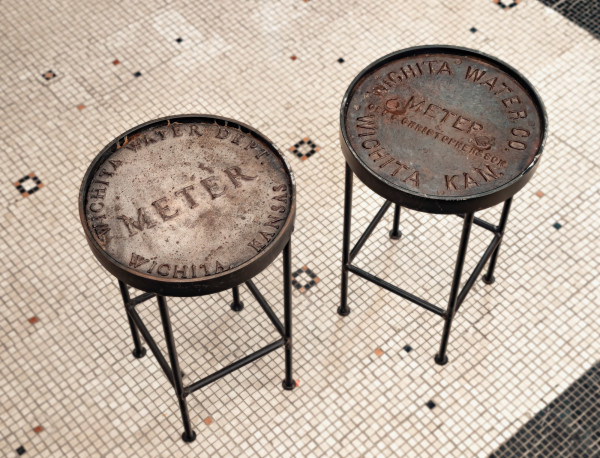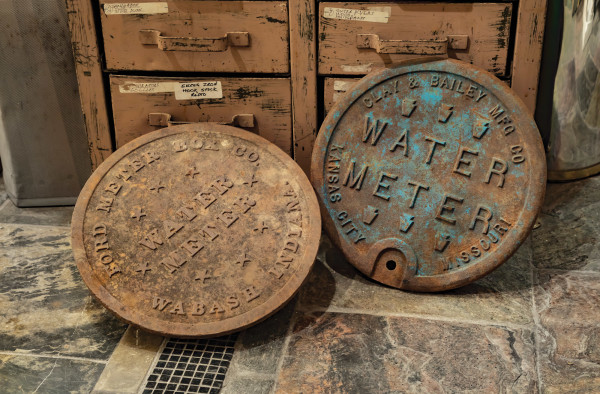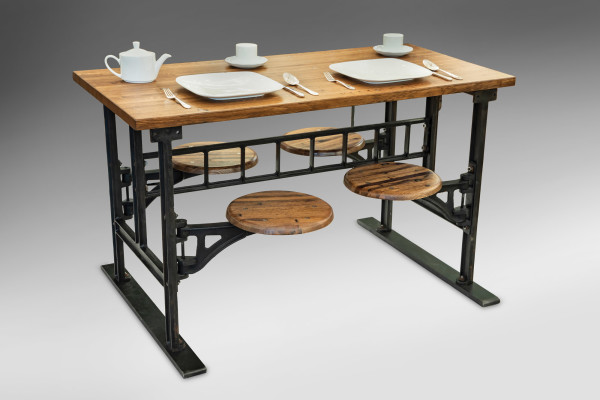The industrial look is strong, especially for kitchens. A visit to Olde Good Things in New York City turned up some unique seating options for the kitchen, breakfast room, or office. Inspired by the high-school laboratory stools of the 1940s and ’50s, OGT converted salvaged, cast-iron meter covers into stools and small tabletops.
At Olde Good Things, water-meter covers are recycled as stools or small tables. John Neitzel
What are they? Back in 1898, Edwin Ford, the waterworks superintendent for Hartford City, Indiana, wanted to be sure customers weren’t wasting water—costing themselves and the city money. So he patented water meters and the boxes to house them. (Patent for the Ford Meter Box Company of Wabash, Ind.) The round, cast-iron boxes protected the meters from harsh Midwestern winters and wear and tear. These Victorian meter boxes were decorative, too, and were soon adapted in other cities: New Orleans, the Crescent City, designed covers featuring a crescent moon and stars, which are very collectible today. (On Etsy, you can find earrings that mimic the cover design!) Don’t filch a cover off the street, though; recently, a woman prying up a cover in New Orleans got herself arrested.
These meter covers will be cleaned, but the original patina is left intact. John Neitzel
The Process
1. CLEANUP & FINISH
Each cover is cleaned with soap and water and a stiff wire brush, removing debris and peeling paint but preserving as much original patina and detail as possible. A coat of Rust-Oleum rustproof black primer prevents further corrosion. Finally, the metal is sealed with Rust-Oleum Protective Enamel in matte black, which highlights the lettering.
2. MOUNTING ON LEGS
To encircle the round disk, a metal band is formed with a metal bending machine, to sit proud of the cover with a ” lip. Vintage cast-iron rails dismantled from salvaged Brooklyn fences are used to make legs that complement the industrial meter covers. The fence rails are cleaned and sealed in the same manner as the covers, then welded to the metal ring.
3. TOPPING OFF
If the piece is used as a table, a top of tempered glass can be added inside the ring. For stools, a round cushion is optional.
A Sani lunchroom table is set with vintage-1980s plates from the Waldorf Astoria hotel. John Neitzel
A Cool Lunch Table
Made with cast-iron bases and wooden seats that swing out on brackets, Sani factory lunchroom tables were manufactured by the Sani Company of Chicago from the 1920s through World War II. Ads promoted these space-saving, “sanitary” lunch tables as a way to keep workers happy and productive: “Don’t compel your men to eat a cold lunch in a dirty place. They will do more work and better work if served a hot lunch in a clean place.”
Olde Good Things has turned the idea into a neat, post-1925 alternative to the breakfast nook. With castings from original tables found in a WWII-era airplane hangar, the company is reproducing the lunch tables using salvaged parts. Connected by girders or stretchers, two heavy iron bases anchor the table, which is so well balanced it doesn’t require a floor bolt. Original wood tabletops had decayed, so new ones were made from recycled pine and oak flooring (and, occasionally, marble). The tables with swing-out seats may be customized for height and number of stools.







